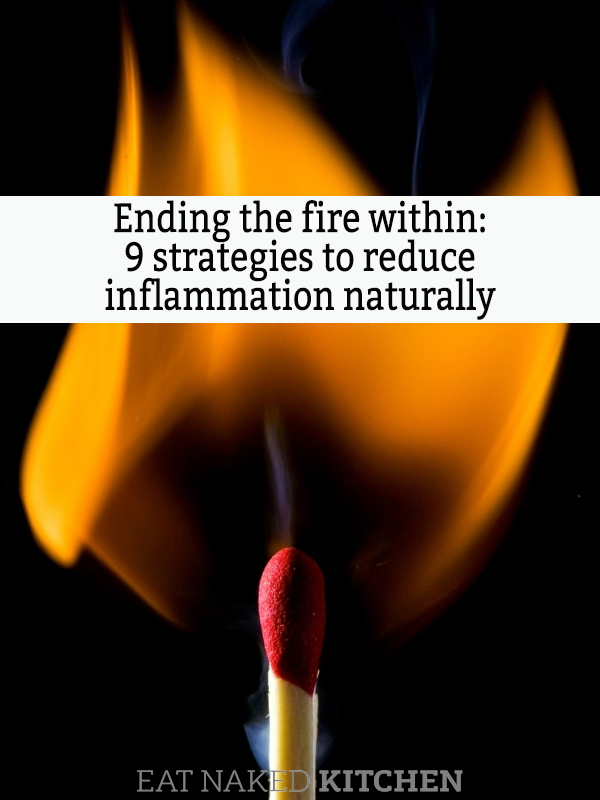(a) to excite to excessive or uncontrollable action or feeling
(b) to make more heated or violent
(c) to set on fire
(d) to cause to redden or grow hot (1)
Inflammation. It’s a hot word these days (sorry, I couldn’t help it). Seems like everyone’s got it. And indeed, it is the sign of an immune system working hard. Here’s the formal definition:
a local response to cellular injury that is marked by capillary dilatation, leukocytic infiltration, redness, heat, and pain and that serves as a mechanism initiating the elimination of noxious agents and of damaged tissue (2)
Inflammation in and of itself isn’t a bad thing. It’s an appropriate response to damage in the body. The trouble happens when there’s chronic inflammation (what is causing this ongoing damage?) and when the body isn’t able to anti-inflame or to bring that inflammation down.
Any conversation about natural ways to reduce inflammation needs to address these two aspects: How do we remove the things that are causing inflammation to begin with? And how do we make sure our bodies have what they need to anti-inflame? Here are nine things to get you started.
1) Eat more and better fats.
Move over inflammatory vegetable oils (sunflower, safflower, corn, soy, cottonseed, canola…) and bring on the real, anti-inflammatory fats: extra virgin olive oil, fats from healthy, pastured animals (butter or ghee from grass-fed cows, eggs from pastured chickens), wild fish, avocados, coconut oil.
And trans fats? Don’t even get me started. They are extremely inflammatory and should be banished from your kitchen. Eating trans fats is kind of like running a cheese grater through your veins.
Fat-phobia has gone out of style with ketogenic diets gaining in popularity, but if you’re still feeling fat-phobic, here’s something I wrote a while back that explains why fats aren’t something to be afraid of, even when we’re talking about weight loss.
2) Eliminate processed and packaged foods from your diet.
Let’s face it, all that processing not only denatures food and renders it a nutritionally vacant shadow of its former self, but it can also make something that was once nourishing, toxic. There are countless ingredients in processed foods that are inflammatory: from the many forms of sugar (see my next point) and rancid oils (see point #1), to food additives such as aspartame and MSG, to refined grains. All of this is inflammatory. No bueno.
3) Cut the sweet stuff.
Sugar is highly inflammatory – in ALL its forms. An occasional treat once in a while is fine, but it will aggravate any inflammatory condition you have. Also, sugar suppresses the immune system by inhibiting the activity of macrophages, the “big eaters” of the immune system. That is so 2019.
4) Eat more berries.
Since you’re cutting the sweet stuff, this will be your candy: berries. You’d have to live under a rock to avoid all the press berries – in particular blueberries – get. But I’m no elitest – all berries are great, and I say just enjoy whatever’s in season!
5) Eat oily fish.
When I say “oily fish” I’m talking about fish such as wild salmon, sardines, anchovies, and herring. These fish are packed full of Omega 3 fatty acids, which are anti-inflammatory. Try not to overcook these fish, though. Omega 3 fatty acids are extremely delicate, and once rancid, they become pro-inflammatory. It’s actually best to eat them raw (hello sushi) or just seared in some nice butter (the stability of the saturated fats in butter protects the delicate fatty acids in the fish – it’s not just for taste that these two go together!)
6) Eat wild or grass-fed / pastured animal foods.
If you’re an omnivore, then make sure you source foods that come from healthy, pasture-raised animals. Meat and fat from animals fed diets high in corn and soy (= all animals from large commercial ventures, including organic!) are pro-inflammatory. To the contrary, meat from pastured animals contains the optimal balance of anti-inflammatory fatty acids – in a ratio closer to that of wild fish. (Find a grass-fed farmer here or subscribe to Butcher Box.)
7) Eat more seaweed.
Bet you didn’t know that seaweed is extremely anti-inflammatory. As a bonus, seaweed is an incredible source of all sorts of trace minerals vitally important to our health. There are lots of great reasons to eat more of it. A personal favorite of mine is arame, which I use in this salad. Yum!! Wakame and kombu are other great options.
8) Add anti-inflammatory spices to your cooking.
Turmeric, ginger, and garlic in particular. Curry anyone?
9) Eat (or drink) your veggies.
I’m talking in particular about leafy greens, cruciferous veggies, and veggies with lots of deep pigmentation and color hues. Loaded with anti-oxidants, veggies of all types are helpful in reducing oxidation and thus the inflammation that accompanies it. If you’re looking to super-dose, I recommend either a green juice or using them in smoothies – you can get many more veggies (and thus their anti-oxidants) in that way.
If all of this looks like code for “eat real food”, then you’ve got it! You can forget everything above if you just eat naked: real, whole, nutrient-dense foods, prepared properly and consumed mindfully.
Want to read more about inflammation? Check out these great articles:
New Review Investigates the Benefits of Turmeric Supplementation in Chronic Skin Conditions
Stock Your Fridge with Flavonoids
Best and Worst Foods for Flexing Your Immune Strength
6 Ways to Get More Turmeric in your Diet





These are great ideas!
There is another very powerful anti inflammatory component in the egg yolk. It’s called Immunoglobulin Y (IgY) or commonly referred to as antibodies. IgY is an immune system modulator which is proven to dramatically reduce inflammation. It is available in a purified form from a company called IGY Immune Technologies & Life Sciences out of Thunder Bay Ontario. The product is called Vector450 and it cost $30 to $35 a month depending on volume. The results can be astounding; many have much faster healing from injuries and athletes get a fast recovery after long or hard workouts. The antibodies know a good bacteria from a bad one and take it out of commission so it has great gut health improvement potential.
Try it, there are no know side effects and it’s one of the reasons eggs are so good for you!
Great article Margaret! And a good reminder. I know what I’m supposed to do, but sometimes I need a reminder as to why. A&W burgers may use grass fed beef, but the buns, cheese, mayo and French fries break all the rules.